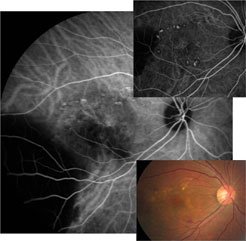Recurrent submacular hemorrhage common in patients with neovascular AMD
Click Here to Manage Email Alerts
Patients with neovascular age-related macular degeneration with submacular hemorrhage on initial presentation have more than a 50% chance of developing recurrent submacular hemorrhage within the first 3 years, a study found.
In 47 eyes of 47 patients, with or without polypoidal choroidal vasculopathy (PCV), 51.1% experienced recurrent submacular hemorrhage, according to the retrospective study published in Retina.
“As a retina specialist in a tertiary referral center, it is not a rare occurrence for me to observe newly diagnosed wet age-related macular degeneration patients presenting with submacular hemorrhage,” co-author June-Gone Kim, MD, told Ocular Surgery News. “These patients frequently show recurrent hemorrhage during follow-up, and visual outcome is anticipated to be poor in this condition. There were no reports about visual outcome of recurrent submacular hemorrhage in AMD patients, and we were curious about the clinical characteristics of these patients with recurrent submacular hemorrhage.”
Recurrent submacular hemorrhage
The study’s finding of a high incidence of recurrent submacular hemorrhage was unexpected, Kim said. The authors were also surprised that recurrent submacular hemorrhage occurs more often in PCV than in typical AMD.
Mean follow-up duration was 36.8 ± 9.8 months. Overall, 68.1% of patients were diagnosed with typical AMD and 31.9% with PCV.
PCV was present in 50% of patients with submacular hemorrhage but in only 13% of patients without recurrent bleeding, a statistically significant difference, according to Kim.


A case of recurrent submacular hemorrhage secondary to polypoidal choroidal vasculopathy.
Images: Kim JG
Treatment with intravitreal anti-VEGF injection correlated with a reduced risk of hemorrhage in patients with PCV.
“We suppose this might be caused by attenuated activity of choroidal neovascularization, as proven in numerous previous studies,” Kim said.
Anti-VEGF injection was administered during the follow-up period in 70.8% of patients with recurrent submacular hemorrhage and in 95.7% of patients without it.
Visual acuity was also maintained during the follow-up period, most likely due to appropriate treatment modalities, such as photodynamic therapy for PCV or anti-VEGF for typical AMD.
“However, patients in our study presented low visual acuity at baseline, between 20/200 and 40/200, because of macula-damaging subretinal hemorrhage,” Kim said. “From a different point of view, it can be construed that visual improvement was not significant, even after resolution of submacular hemorrhage.”
To select the 47 patients eligible for study inclusion, the authors reviewed the medical records of 948 neovascular AMD patients who had their first visit to a single center between January 2004 and January 2008.
“In this large number of patients, we found PCV accounts for about 23% of total subjects,” Kim said. “The prevalence of PCV can be surmised from this result, at least in the Northeast Asian population.”
Furthermore, the interval to recurrence bleeding after PDT in PCV patients was 17.1 months, which indicates that the interval between 1 and 2 years is a critical period during which physicians should be concerned about recurrence of submacular hemorrhage in PCV patients treated with PDT, Kim said.
The overall value of the study is identifying that recurrent submacular hemorrhages are truly a sign of PCV and that patients with AMD who suffer from this condition should be reassessed for this diagnosis, according to Kim.
Kim is planning a future study with a larger pool of patients.
“The number of PCV subjects without recurrent hemorrhage in our present study was not enough to perform detailed statistical analysis,” Kim said. A prospective, comparative trial is also needed to further validate the results. – by Bob Kronemyer
Reference:
- Hwang JU, Yang SJ, Yoon YH, Lee JY, Kim JG. Recurrent submacular hemorrhage in patients with neovascular age-related macular degeneration. Retina. 2012;32(4):652-657.
For more information:
- June-Gone Kim, MD, can be reached at Department of Ophthalmology, Asan Medical Center, University of Ulsan College of Medicine, 388-1, Pungnap-Dong, Songpa-Gu, Seoul 138-736, Korea; 82-2-3010-3673; email: junekim@amc.seoul.kr.
- Disclosure: Kim has no relevant financial disclosures.
